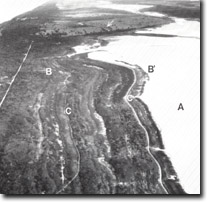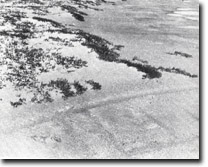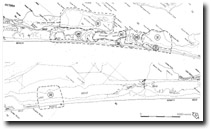GL33 (8321) Lake Reeve and Outer Barrier - Paradise Beach
|
This information has been developed from the publications:
|
| Location: | 365732, 382740 (8321). 6 kilometres north-east of Golden Beach. |  Lake Reeve near Golden Beach. Lake Reeve (A). Contraction ridges (B-B'). Eroding vehicle tracks (C). Former tidal channel (arrowed). |
Abstract: | Saline lagoon, salt and mud flats, contraction ridges, outer barrier ridges. | |
Access: | Track from Paradise Beach. | |
Ownership: | Crown land (The Lakes National Park and Gippsland Lakes Coastal Park) and private land. | |
Geomorphology: | The outer barrier in the vicinity of Paradise Beach is comprised of 10 to 13 parallel dune ridges, the maximum number found along the entire length of the Ninety Mile Beach. The dunes show clear evidence of increasing age towards Lake Reeve. Those near the Ninety Mile Beach consist of unbleached sand with dune grass and Acacia longifolia vegetation, but further inland leaching of the sand is evident. This extends to depths of two metres on the oldest dunes, the leached zone underlain by sand stained reddish-brown but without the coherence of true coffee-rock. Small blowouts cross the outermost ridges in several places, the alignment of the axes of these being approximately 30o more westerly compared with those near Ocean Grange. | |
Behind the outer barrier and extending from Seaspray for over 60 kilometres to Rotomah Island is Lake Reeve, a narrow and very shallow lagoon. The floor of Lake Reeve is of sand, shell and mud, and as large areas of the lagoon frequently dry up completely, extensive saline mud and sand flats develop. Reed growth is limited by the high soil and water salinities and the dominant plant communities around the shoreline are Gahnia sedgeland, Juncus rushland and Salicornia herbfield. | ||
Along much of the shoreline of Lake Reeve, are sets of low, curving parallel ridges, the ridge crests commonly only 5 centimetres to 30 or 40 centimetres above the intervening swales. The ridges are often shelly, or of silty sand, those nearest the lake vegetated by Salicornia or Hemichroa, while those further back may have a more complex salt marsh association including the taller plants Juncus and Arthrocnemum. The ridges are built up by wave action at times of high lake level and are stranded as the level falls, hence they are small scale beach ridges although some are more clearly chenier ridges. They indicate a progressive reclamation of Lake Reeve by shoreline progradation and have been termed contraction ridges or cocentric ridges. They are best developed on the eastern shoreline due to the predominance of wave action here generated by westerly winds. | ||
| Significance: | State. The area includes the widest section of the outer barrier of the Gippsland Lakes, and the area with the greatest number of parallel ridges. Lake Reeve with its extensive saltmarsh and shoreline contraction ridges differs fundamentally from other lagoons in the Gippsland Lakes area in both geomorphologic and ecological characteristics. | |
Management: | The relief is highly sensitive to disturbance by excessive grazing and by uncontrolled access of off-road vehicles. Disturbance to vegetation on the coastal dune grass and scrubland, and the salt marsh ridges and swales around Lake Reeve is leading to accelerated wind and water erosion in several areas. Control should be exercised over the activities mentioned above to reduce the deterioration of the sensitive landform and vegetation associations. | |
References: | Jenkin, J.J. (1968). "The geomorphology and upper Cainozoic gelogy of Southeast Gippsland, Victoria", Geol. Surv. Vict. Memoir 27. Ladd, P.G., Ladiges, P.Y. and Calder, D.M. (1976). Vegetation surrounding the Gippsland Lakes and Lake Tyers. Publication No. 131., Environmental studies Series, Ministry for Conservation, Vict. Bird, E.C.F. (1978). The Geomorphology of the Gippsland Lakes Region. Publication No. 186, Environmental Studies Series, Ministry for Conservation, Victoria. | |
 Salicornia colonising newly formed contraction ridges - Lake Reeve |



